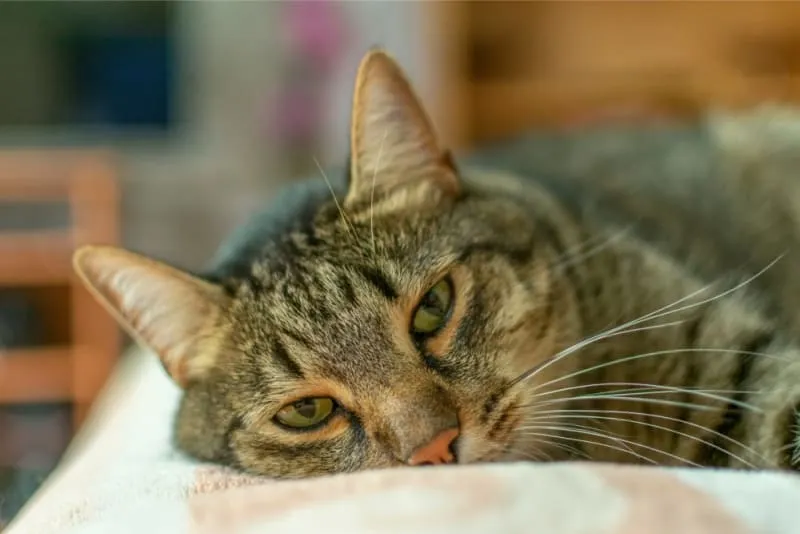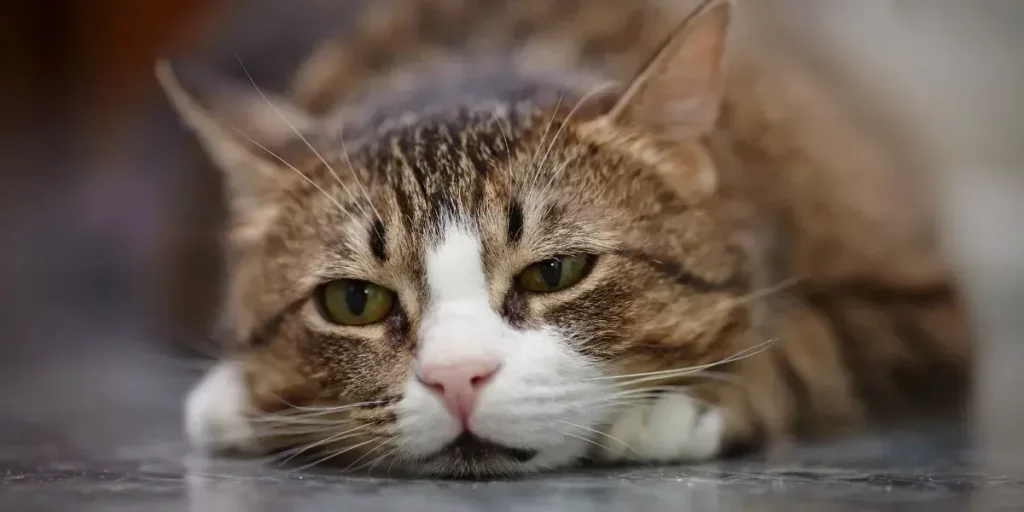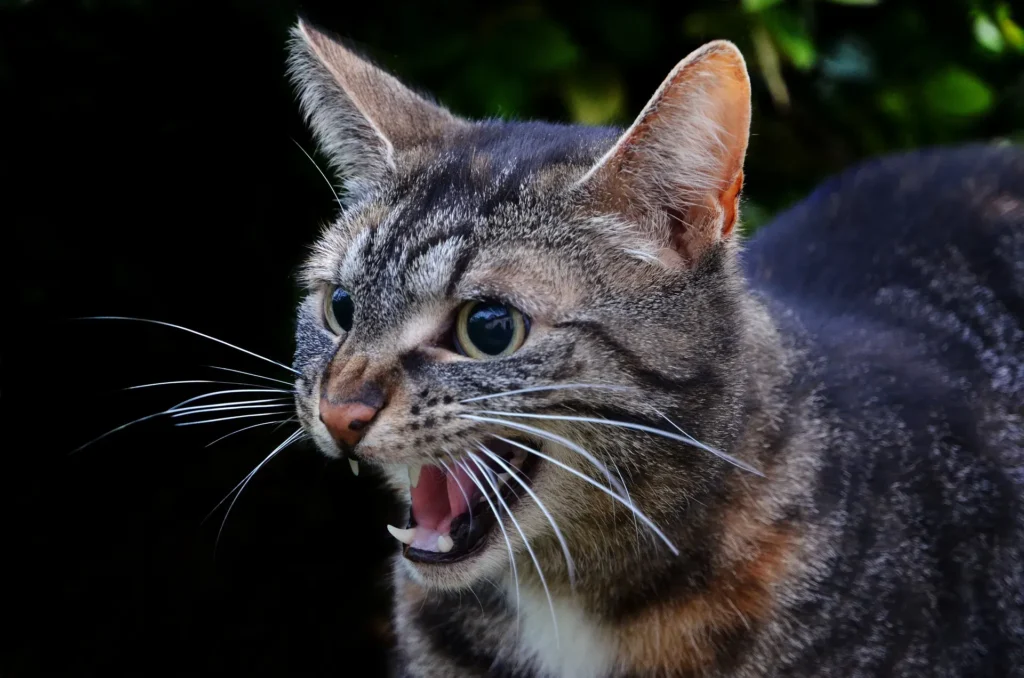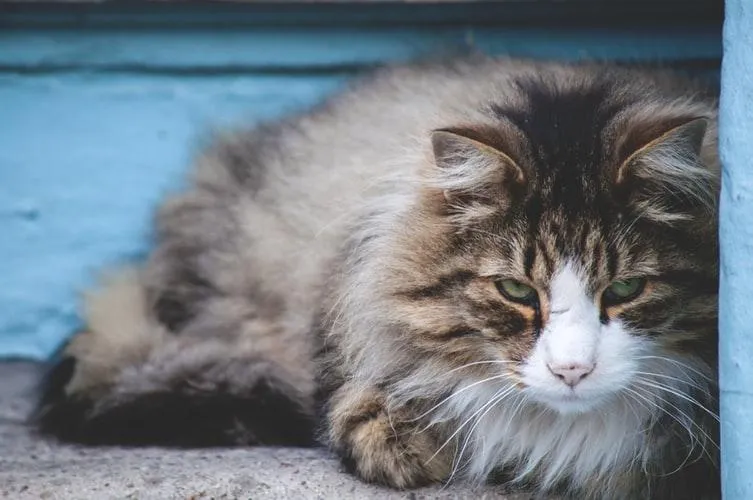Are you noticing potential signs of rabies in your cat’s eyes? Are you seeking confirmation and information on these symptoms? Keep reading to learn about the various signs of rabies in cats.

Rabies is a severe and fatal viral disease that affects various mammals, including cats. It’s a zoonotic disease, meaning it can be transmitted from cats to humans.
As a responsible pet owner, it’s crucial to understand the signs and symptoms of rabies, especially those that may appear in a cat’s eyes. This is for both the health of your cat and the safety of humans.
Signs of Rabies in Cats Eyes

Here are the potential signs of rabies in cats’ eyes
1. Excessive Tears from Their Eyes
Cats with rabies often display abnormal eye behaviors, one of the most noticeable being excessive tear production. This symptom can make the eyes appear constantly wet and may cause the fur around the eyes to become damp or stained.
Additionally, the cat might show signs of discomfort, such as squinting or pawing at their eyes, indicating sensitivity to light or irritation.
These changes suggest an underlying ocular issue potentially related to rabies, as the virus can affect the nervous system, leading to various eye-related symptoms.
2. Noticing Changes in Eye Appearance
Rabies may cause noticeable changes in the appearance of a cat’s eyes. A cat infected with rabies might develop a hazy or opaque look in their eyes, which can make them appear glassy or lackluster.
Redness or inflammation can also be evident, possibly accompanied by the protrusion of the third eyelid, giving the eyes an unusual appearance.
Visible lesions or sores around the eyes can further indicate an infection, emphasizing the need for prompt veterinary attention to address these alarming symptoms.
3. Aggressive or Unusual Behavior From Your Cat
Behavioral changes are common in cats affected by rabies. If your cat suddenly becomes unusually aggressive or displays unexplained restlessness or agitation, these could be signs of the disease.
Rabies can cause significant changes in a cat’s neurological system, leading to symptoms like uncoordinated movements, disorientation, and paralysis.
These neurological impairments often affect the eyes, causing abnormal eye movements or an inability to focus. Monitoring for these behavioral and physical changes can help in early detection of the disease.
4. Excessive Drooling and Difficulty Swallowing
Rabies can significantly impact a cat’s ability to swallow, leading to excessive drooling or foaming at the mouth. This is often coupled with difficulty swallowing, making it a strong indicator of the disease.
Cats might also paw at their mouths in discomfort, reflecting neurological impairment caused by the virus. The inability to control salivation and swallowing can further stress the cat’s health. This can contribute to additional symptoms like dehydration and malnutrition.
5. Changes in Their Vocal Patterns
Cats with rabies might exhibit changes in their vocalizations. They may produce unusual sounds or, conversely, become completely silent. Any deviation from their normal vocal behavior can be an indication of a health issue, including rabies.
These vocal changes can be accompanied by other signs of distress or illness, such as changes in eye appearance and behavior, highlighting the need for comprehensive observation and immediate veterinary care.
6. Noticing Your Cat Exhibiting Seizures or Paralysis
Rabies can lead to severe neurological complications, including seizures or partial or complete paralysis. A cat experiencing these symptoms might show tremors, sudden collapse, or uncontrollable movements.
Changes in eye movements, such as rapid blinking or involuntary rolling of the eyes, often accompany these neurological symptoms. These severe signs indicate advanced stages of the disease, requiring urgent veterinary intervention.
7. Noticing Fever and Weakness From Your Cat
Fever is a common sign of many illnesses, including rabies. An increase in body temperature, coupled with overall weakness or lethargy, might suggest the presence of this viral disease.
A cat with a fever may exhibit glassy eyes, reduced activity, and a lack of interest in usual activities. The combination of fever and other symptoms like changes in eye appearance or behavior should prompt immediate veterinary evaluation.
8. Disorientation and Confusion in Affected Cats
Rabies often leads to disorientation and confusion in affected cats. This can manifest as increased agitation, restlessness, or even an aversion to usual human contact. Such behavioral changes are often reflected in the cat’s eyes.
This comes with signs like unfocused gazes, erratic eye movements, or an inability to recognize familiar faces or surroundings. Observing these signs alongside other symptoms of rabies can help in early diagnosis and intervention.
In conclusion, if you suspect any of these symptoms, seeking immediate veterinary care is essential. Rabies is a fatal disease with no cure once symptoms appear, so prompt action can prevent the spread of this highly infectious disease and ensure your cat’s well-being.
Monitoring your cat’s health closely and being aware of these signs can make a significant difference in managing their health and safety.
Will a Cat With Rabies Eat and Drink?

A cat with rabies is unlikely to eat and drink normally as the disease progresses. Rabies, a viral infection affecting the central nervous system, significantly alters a cat’s behavior and physical capabilities.
In the early stages, a cat might still consume food and water, but as the disease advances, symptoms become more severe. These can include difficulty swallowing due to paralysis of the throat muscles, leading to drooling and inability to eat or drink.
Additionally, the cat may exhibit signs of agitation, aggression, or extreme lethargy, all of which can interfere with normal eating and drinking habits.
Ultimately, as rabies progresses, the cat’s condition will deteriorate to the point where it can no longer sustain basic functions, including eating and drinking.
If rabies is suspected, it’s crucial to seek immediate veterinary attention, as rabies is almost always fatal once symptoms appear and pose a significant health risk to humans and other animals.
What Are the First Signs of Rabies in Cats’ Eyes?
The first signs of rabies in a cat’s eyes can include noticeable changes in behavior and physical appearance. Initially, a cat may exhibit subtle behavioral changes such as increased aggression, restlessness, or unusual friendliness if they were previously timid.
As the disease progresses, changes in the eyes become more apparent. These can include dilation of the pupils, resulting in an unusually intense stare or difficulty in focusing. The eyes might appear glassy or have an unusual shine, and there could be rapid, involuntary eye movements known as nystagmus.
Additionally, as the rabies virus affects the neurological system, the cat may lose its blink reflex and experience partial facial paralysis, making the eyes look asymmetrical.
Recognizing these early signs is crucial, as rabies is a fatal disease once symptoms manifest. Immediate veterinary intervention is necessary to manage the situation and ensure the safety of both the cat and humans.
Is Sneezing a Sign of Rabies in Cats?
Sneezing is not typically a sign of rabies in cats. Rabies primarily affects the nervous system, leading to symptoms such as behavioral changes, aggression, paralysis, excessive drooling, and difficulty swallowing.
Sneezing, on the other hand, is generally associated with respiratory issues, allergies, or upper respiratory infections, such as feline herpesvirus or calicivirus.
While a cat with rabies might exhibit various unusual behaviors and symptoms due to the neurological impact of the virus, sneezing is not considered a hallmark symptom. If your cat is sneezing frequently, it is more likely due to a respiratory infection or allergy.
However, if there are other concerning symptoms such as changes in behavior, difficulty swallowing, excessive drooling, or signs of neurological distress. It is essential to seek veterinary care promptly to rule out serious conditions like rabies and ensure appropriate treatment.
Related Searches:
